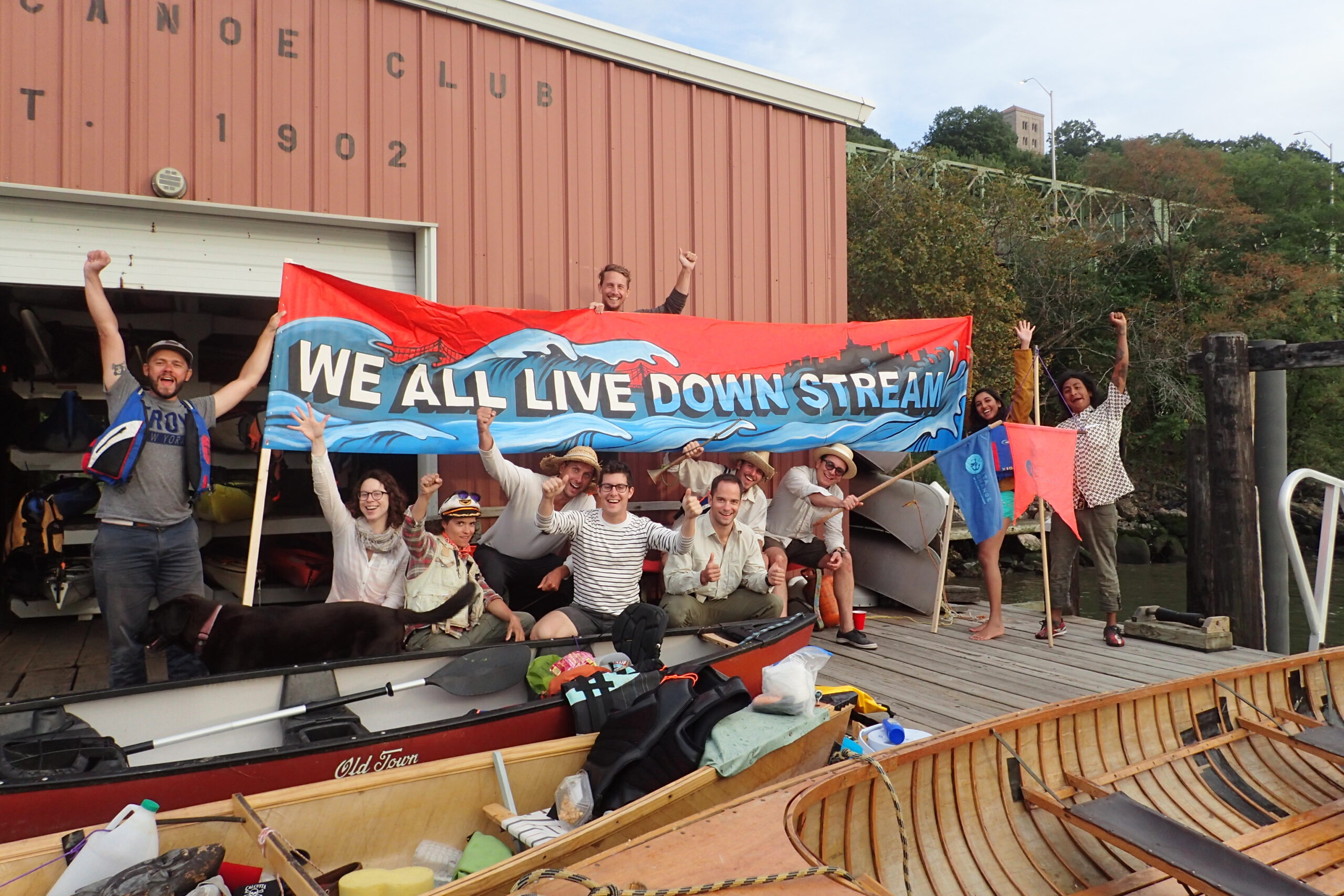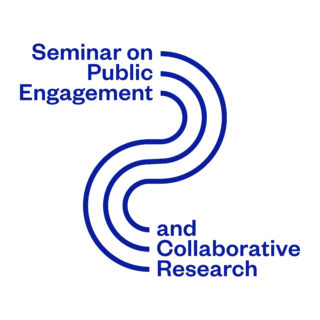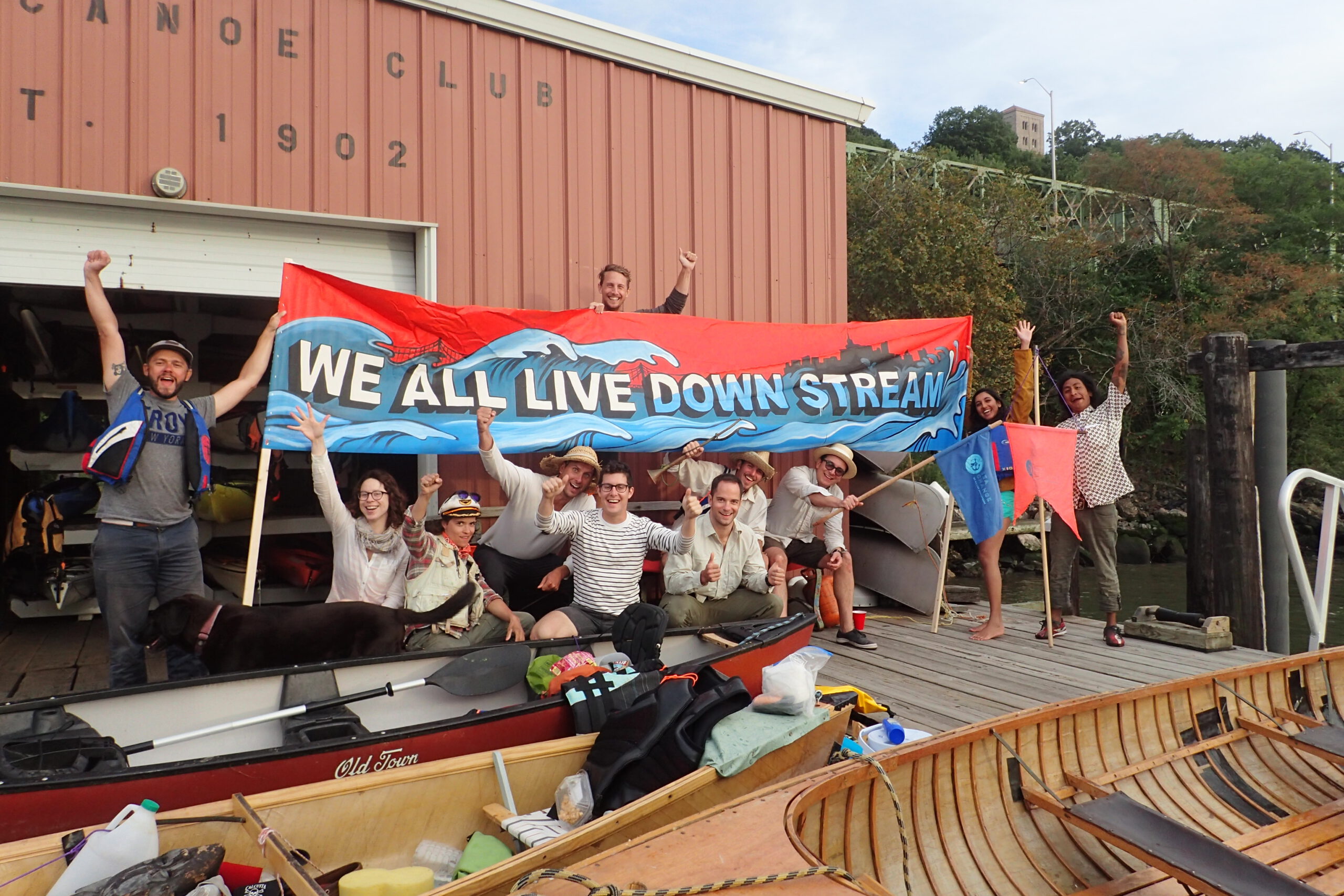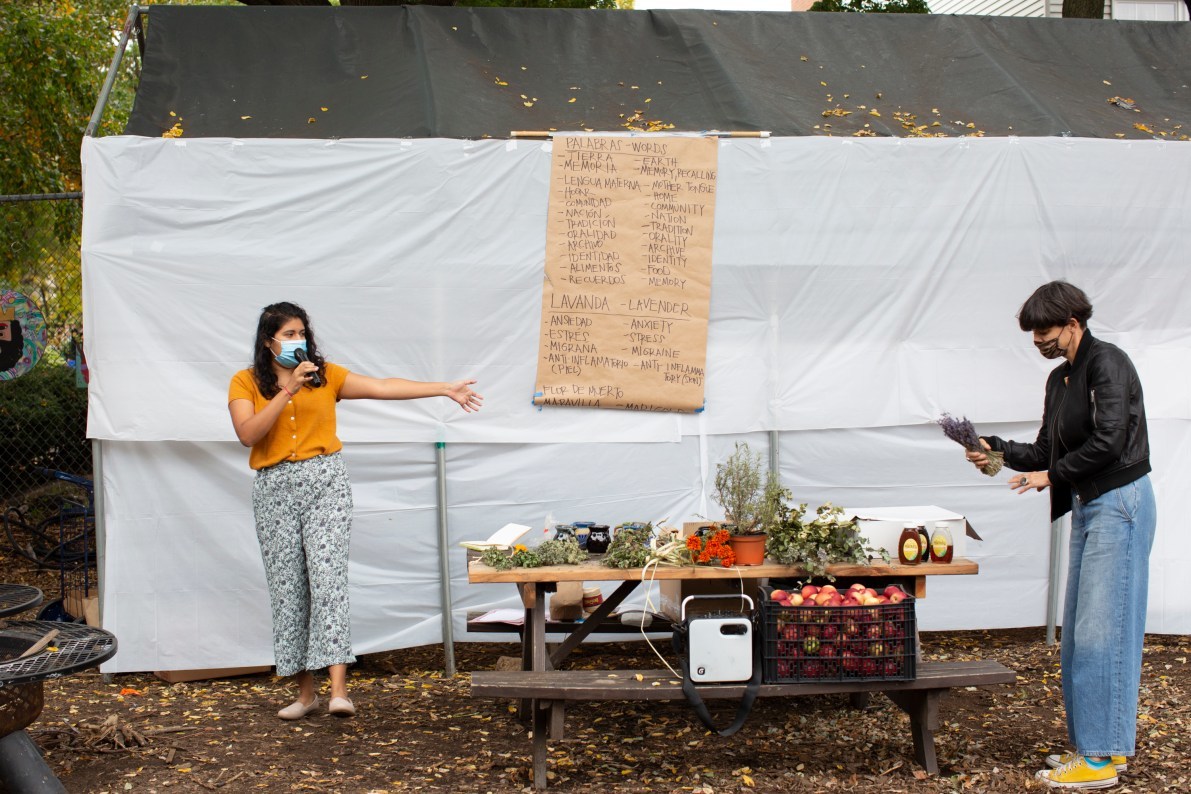Embracing Your Whole Self through Your Public Commitments: An Interview with Kendra Sullivan
February 16, 2022


Via this series of interviews, Distributaries seeks to sketch out the contours of the public humanities ecosystem—the centers, institutes and initiatives undertaking the work of the public humanities—at the City University of New York. Apart from sharing the specific work these programs and centers do, we also wish to offer up their visions of the “public humanities” as a field, and the rich ways in which the ethos of this term is realized.
In this interview, I speak to Kendra Sullivan, Director of the Seminar on Public Engagement and Collaborative Research from the Center for the Humanities at The Graduate Center, CUNY. From her deeply collaborative and constructive understanding of the public humanities as a field, to her experience of becoming involved with this work by building boats and traveling down rivers for weeks on end, Kendra allowed me to sit with the expansive forms publicly engaged work can take. I hope you find your takeaways from this interview to be as rich and stimulating!
–Queenie Sukhadia

Queenie Sukhadia: My first question for you is: How do you understand the term “public humanities”?
Kendra Sullivan: In the context of a public, urban university like CUNY, I think of the public humanities as a suite of collaborative meaning-making strategies that learn from and feed into social justice movements throughout New York City. Public humanities methodologies can foreground endangered or precarious knowledge practices while also opening up new knowledge frontiers. These practices are based in mutuality and should make the material and immaterial conditions of life better for participants!
Public humanities strategies—like collaborative artistic creation, humanities-based case studies, radical archiving, and even direct action as research, to name a few—reimagine the role of the university in conversation with the wider communities in which it is situated. These strategies and commitments have the potential to become enculturated across the city as many CUNY scholars and practitioners plan projects and build out infrastructure for a more equitable, capacious university dedicated to progressive change and collective uplift.
Traditionally, educators are tasked with preparing students to succeed in life, which I think of as teaching people about what the world is like and how to “work it” in order to maximize individual success and economic mobility. Some of us also talk a lot about fostering in students the practical, social, critical, and creative skills to intervene into the way society works, actively constructing better worlds. But I often wonder what would happen if universities opted to take more responsibility for the shape of the world its students enter into—before and after they enter into it. What would have to happen—practically, how would resources flow and missions, boards, committees, professionalization and compensation structures, and decision-making practices shift—if university administrations really owned the fact that their fate is tied up with the fates of communities unaffiliated with the university in any way, but who are nonetheless actively analyzing, theorizing, and acting in and on the worlds we share? I want to be careful here, because this relational shift should be toward solidarity rather than a charity model of engagement. One of the aims of public humanities work is to reverse hierarchies that inform certain ideas about value and power that a charity-based model reproduces. This kind of total shift toward an expansive, ecosystemic mutuality is actually kind of hard to imagine in a contemporary, market-driven education economy, but I have to say I see and feel CUNY colleagues making it happen every day!
For example, Professor Naomi Schiller at Brooklyn College contributes to debates about how to advance democratic and just decision making around land use in New York City. Her collective oral history project will produce knowledge and tools that could have a democratizing impact on the Uniform Land Use Review Procedure (ULURP), the City’s decision-make processes for making changes to land use, such as rezonings. Professor Terri Watson at City College is dedicated to building Beloved Community, which amplifies the agency of Harlem’s mothers as a powerful resource in education research and advocacy. Professor Michael Menser at Brooklyn College really inspires me because of his simultaneous commitment to education, resilience, and civic engagement. He’s teaching classes at Brooklyn College on philosophy, urban studies, and participatory budgeting; he’s building out campus food banks, kitchens, and gardens—open to CUNY adjacent communities, incubating spaces for informal knowledge to proliferate among Brooklyn residents with a huge array of expertise while distributing healthy food. He’s also working with the union PSC, the Mayor’s Office of Resilience, and Participatory Budgeting to create avenues for the students he teaches to become a part of decision-making processes at the city and state level. Menser often says, “CUNY can solve this crisis!” And “the crisis” there is deliberately open ended: by intervening in meaningful ways, CUNY has the scale, talent, and capacity to solve some of the really big problems that this city is facing economically, environmentally, and more!
But I often wonder what would happen if universities opted to take more responsibility for the shape of the world its students enter into—before and after they enter into it.
Ideologically, I think public humanities work erodes harmful patterns of binary thinking, binaries like inside-outside, belonging-nonbelonging, expert and non-expert, nature and culture, the binary of knowledge practices vs. creative practices, and so on. While we break down these divisions, we build up actual infrastructure for change that allows for the sustained, bidirectional flow of people, ideas, and resources between diverse communities who are simultaneously making their own situational assessments, making their own culture and meaning, making their own fun, making their own futures, and so on. In my experience, and in spite of the tremendously difficult and sometimes downright painful challenges addressed, the public humanities are joy-filled and justice-fueled.
In the video above, see Mellon Seminar Faculty Leads Naomi Schiller, Michael Menser, Ángeles Donoso Macaya, and Ryan Mann-Hamilton discuss their overlapping projects and research on food justice.
QS: I love that expansive notion of the public humanities. My next question is about your journey. Can you tell me a little bit about how you came to your current role as Director of the Seminar on Public Engagement and Collaborative Research? What motivated you to get involved with the public humanities?
KS: Sure, it’s such a long-winded story though! I was a painter but I dropped out of the NYC painting world because corporate art culture was not for me. I struggled for a bit, trying to figure out how to channel my creative impulses in a way that felt constructive—quite literally, in terms of making things with my hands, but also metaphorically, in terms of contributing tangible good toward the society I wanted to be a part of, toward broader systems change and social uplift.
I started building boats. A group of collaborators, including artists, lawyers, nature educators, and policy makers, built a barge and traveled down the Susquehanna River for four weeks every summer for three summers in a row to film a documentary about the incursion of the fracking industry on the Marcellus Shale, directed by one of my best friends, Meryl O’Connor. During our voyages, we recorded conversations with the people on its banks whose lives were entwined in the oil industry. We gathered firsthand accounts of land sales, when post-agricultural locals were so enthused about the future being sold to them, and later, when locals were starting to get sick from sharing well water with the hydraulic fracturing plants and beginning to organize against extreme energy in earnest.

It became so clear to me during that process: art has an important place in world making! In my experience, the creative process brings very different people into deep relationships and conversations. The kinds of overwhelming complexities humans (and nonhumans) face today require collective and collaborative thought and action: this project made it clear to me that I didn’t want to be a solo artist; I wanted to make meaning and meaningful change in community. Community became a kind of art praxis and this mode of collaborative, creative, and activist research became my primary methodology through my art collective, Mare Liberum. But it would still be many years before I got my job at the Graduate Center, CUNY!
Through the seminar, it’s my hope, on an individual level, that everyone who collaborates with us gets to bring their whole selves to the table. You can be an artist-scholar-mother-activist-boat-builder-poet-publisher-whateverer.
Eventually, I met Sampson Starkweather at the Center for the Humanities at a poetry reading (Harmony Holiday was reading) and he alerted me to a job opening at the Center. During my interview, Director Aoibheann Sweeney asked about my background, and I said, well, “I am an artist, but kind of a dropout artist, and a boat-builder. I build boats and teach people to build boats and take them out of urban waterways to talk about issues related to environmental justice. I was publisher for a little while, and a printmaker, and then I ran a nonprofit art gallery for four years, and oh and I also write poetry!” To my surprise, she responded, “Oh, that’s perfect for our Center!” Being embraced in all my individual plurality as part of our amazing team at the Center was transformative. It seems to me that people—especially in the workplace—usually want you to be one or maybe two things, right? In the past, I found I was allowed to be an artist or a writer or an academic, but not all three. It wasn’t always easy to say, “everything interests me; my commitments are super widespread—sometimes I’m a poet and sometimes I spend whole summers on the river and sometimes I’m an arts administrator but sometimes my work brings me into policy debate”—even when that’s absolutely true!
Through the Seminar, it’s my hope, on an individual level, that everyone who collaborates with us gets to bring their whole selves to the table. You can be an artist-scholar-mother-activist-boat-builder-poet-publisher-whateverer. I often think about a famous Audre Lorde quote, “There is no such thing as a single-issue struggle because we don’t live single-issue lives.” I have found that when people bring their whole selves to a problem, they understand and address in complex, intersectional ways that really open up new ways forward. Similarly, when we bring our whole group’s attention to a project as a seminar cohort, we do so transdisciplinarily, transforming the modes, methods, and outcomes of our research in richly transformative ways.
QS: What was your most rewarding moment and your most challenging one in your current role?
KS: The best work from the Seminar is grounded in creative activity that creates cultural value while energizing social movements. While grounded in humanistic theory, analysis, and action, the Seminar draws from CBPAR (Community Based Participatory Action Research). One of the most important goals of the project is building community capacity building, meaning the partners we work with enhance their creative, cultural, social, and political power in practical and lasting ways through our collaboration.
A good example is a current project working in solidarity with the migrant justice movement, co-organized by faculty lead Angeles Donoso Macaya (BMCC), community lead Carolina Saavedra (a sous chef at La Morada in the Bronx), and student lead Pedro Cabello del Moral (LAILAC, GC). La Morada is an Oaxacan restaurant, a site of undocumented-led struggle and uplift, a mutual aid hub (especially since COVID), and an arts/culture space. At the Center, we’re working to secure funding for Saavedra and her community partners as they procure and steward multiple public gardens in the Bronx to grow healthy food; teach culturally specific food and herbal preparation practices; and program community events, activities, and workshops in the arts, sciences, and political education. We hope, through our collaboration, to offer some practical support as La Morada expands their already robust platform for mutual aid through grant writing, funding partnerships, film and media campaigns, and stronger relationships to immigration scholar-activists working in CUNY contexts. But it’s important to say that the knowledge and expertise is firmly in the hands of the Saavedras in this context. They have connections to diasporic communities in the Bronx, who bring their knowledge of the historical and medicinal value of plants in a decolonial setting to neighborhood artists, educators, and activists who will help program the garden; to garden stewards and land trust members, who can facilitate the rehabilitation of garden spaces; and to farms and nurseries, who are willing to donate seeds, plants, and trees to get the gardens started. What we have is infrastructure and capacity that we can lend to their efforts to build out their own infrastructure and capacity. Why is this happening through a university and not an NGO, say? Because knowledge flowing between CUNY and NYC communities surfaces essential ways of knowing and worlding that remain covered over when academic/nonacademic spaces remain siloed and where artificial borders between CUNY/the city, the expert/non-expert, the academic/organic intellectual, and local knowledge/technical expertise remain intact. What’s more, so many CUNY students are looking—through CUNY—for an entryway into and role to play in the social, political, economic, and cultural decision-making practices of NYC. Relationships like the one Donoso Macaya and Saavedra are crafting create and maintain opportunities for CUNY faculty and students and community partners to shape and reshape—in concert—the city they share.

Professor Wayne Koestenbaum once commented that the Center is as much an art collective as it is an academic institute and, I have to say, I find the company we keep and make here creatively, intellectually, and ethically inspiring: my core team Alisa Besher, Jordan Lord, Stephon Lawrence, and Sampson Starkweather are all leaders in their respective fields as well as stellar at their jobs. Alisa is an ASL interpreter and arts educator; Jordan Lord is a filmmaker and artist; and Stephon Lawrence, Ammiel Alcalay, and Sampson Starkweather are incredible poets and publishers who bring their talent, experience, and networks into our work together. Learning and growing—as a person and as an organization—alongside this team of superstars has been more than rewarding, it’s been transformative. The kind of things we learn together are the kinds of knowledge that change you and the world in equal measure. It’s a reward and a challenge, this kind of relationality, dependence, and willingness to change and respond as new urgencies and paradigms assert themselves.
Beyond that immediate circle, I’m so privileged to work with institutional leaders like Drs. Joy Connolly, David Olan, Robert Ried-Pharr, Herman Bennett, and Aoibheann Sweeney, my first boss and favorite trailblazer. And of course, through Lost & Found, I’ve worked with Ammiel, but also Diane di Prima, Joanne Kyger, and Amiri Baraka and editors/friends like Megan Paslawski, Zohra Saed, Tonya Foster, and Iris Cushing, and again, that’s only mentioning a few! With the CUNY Adjunct Incubator and through Just Research, I get to work closely with Celina Su, a total heroine of mine, as well amazing educators like Conor Tomás Reed, Aurash Kwarazad, and Kendra Krueger.
In 2020, I sat in on a class with Eduardo Vianna (team taught with Cathy Davidson), and there I learned about his idea of a collectividual, his term for who we become when we work in concert with others toward a common social, education, creative, developmental, or political goal.
How to build out sustainable institutional capacity to support this kind of education system and make sure everyone is taken care of professionally and financially in the process is, of course, the biggest challenge, our greatest motivator, the ever-receding horizon that we keep working toward.
My work family is my chosen family, and in all its myriad formations and instantiations it’s something I’m grateful for everyday. This “collective,” as Wayne called us, however loosely defined, is so rewarding in and of itself. I guess, finally, it’s this idea that we’re always making space for change, making relationships that allow for and support good change on the personal, institutional, and social level. We’re working together to make CUNY (and NYC) a more capacious and hospitable place that allows for maximal social uplift, reciprocity, and joy, and in little moments every day, with each other and with new collaborators on a regular basis, I feel like it’s happening. I hope (against hope) that it’s happening more and more for more and more people, even and especially as crisis unfold within and beyond the walls of the university. How to build out sustainable institutional capacity to support this kind of education system and make sure everyone is taken care of professionally and financially in the process is, of course, the biggest challenge, our greatest motivator, the ever-receding horizon that we keep working toward.
QS: What do you think are the biggest challenges “public humanities” as a field is encountering today? As Director of the Seminar, what are some of the common challenges you have seen practitioners of the public humanities face and how have they navigated them?
KS: How do we convince the institution that collective uplift—the flourishing of those inside and outside the university—is a core function of public higher ed and needs to be resourced as such?
Queenie: How do you think the work of the public humanities can be more institutionalized in universities/departments? Should it be?
KS: Yes! I do think so. How so? Resourcing infrastructure for engagement. Breaking away from assessment culture, audit culture, and from the banking model of education. Moving away from competition and toward collaboration. Acting from a sense of answerability to the publics the institution serves. Acknowledging that no one person or group of people has the answers we need to solve the intersecting crises we face, so supporting collaborative work across disciplines and difference just makes sense. Paying and promoting full-time faculty based on publicly engaged work alongside other teaching, publishing, and service. Teaching public humanities methodology as a first-year, hands-on, core learning encounter that all freshman experience so that they might incorporate this way of thinking/acting organically into their widely divergent professional lives. Resourcing centers that support this work. Resourcing community partners who are organic intellectuals, actively theorizing and acting on that analysis in the world. Creating space at the university for community leaders to share their knowledge in a way that secures their long-term financial well-being. Hiring CUNY adjuncts as full-time CUNY professors. The list goes on and on.
I’m so honored and happy to be in conversation with Drs. Lizzie Macaulay-Lewis, Anne Valk, Prithi Kanakamedala, Stacy Hartman, and Katina Rogers on building out a focus area on publicly engaged scholarship in the MALS program. These folx are some of the savviest in the country working in and around issues related to the public humanities, and I can’t imagine a better team of individuals planting the seeds for sustainable, institutional futures for this work at CUNY.
Queenie: How do we set up more bidirectional flows between folks within the university and outside of it, so that it’s not only academics going outside and engaging with the public, but outside publics are also being invited inside? How can we make the resources of the university more public, or democratize them, so to speak?
KS: This is the precise aim of the Seminar on Public Engagement and Collaborative Research!
